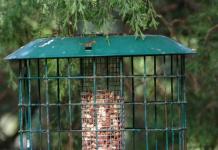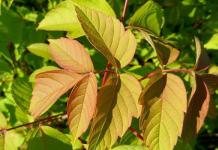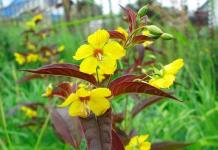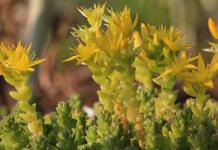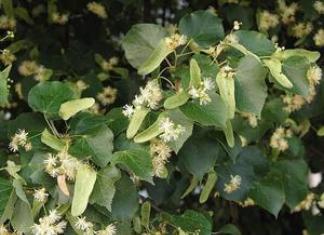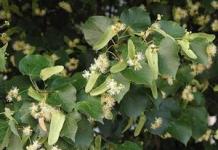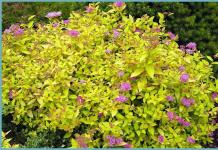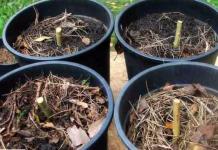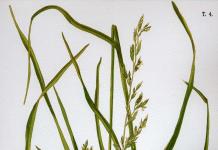Recipes for cooking seasonings from greens for the winter.
In winter, all the greens on store shelves are not at all fragrant. And Chinese imported garlic is not spicy and not odorous at all. Therefore, in the summer, think about winter, and prepare fragrant seasonings.
Cilantern blanks for the winter: seasoning recipe
Cilantro is a spicy herb used in the East. But now, for many summer residents, this grass grows in the garden. Therefore, if you are a fan of spices or fragrant seasonings, prepare a winter preparation of cilantro.
Ingredients:
- 1 kg green cilantro
- 1 lemon
- 100 ml vegetable oil
- ground coriander
- Khmeli-suneli
Recipe:
- Wash and dry the cilantro greens on paper towels. Cut the cilantro into small strips and discard the stems.
- Pour the greens with lemon and sprinkle with spices. Remember a little with your hands so that the cilantro releases the juice.
- Pour in vegetable oil and stir again. Put in jars and close with capron lids. Keep cold.
Seasoning from the arrows of garlic for the winter: a recipe
Unusual and very spicy seasoning. It can be introduced into soups or simply smeared on a sandwich.
Ingredients:
- 500 g garlic cloves
- 50 ml vegetable oil
- ground coriander
- Black pepper
Recipe:
- Sort and rinse the garlic cloves. Pass the greens through a meat grinder.
- Add oil, salt and spices to the resulting puree.
- Arrange in sterilized jars and close with a nylon lid, store in the cold.
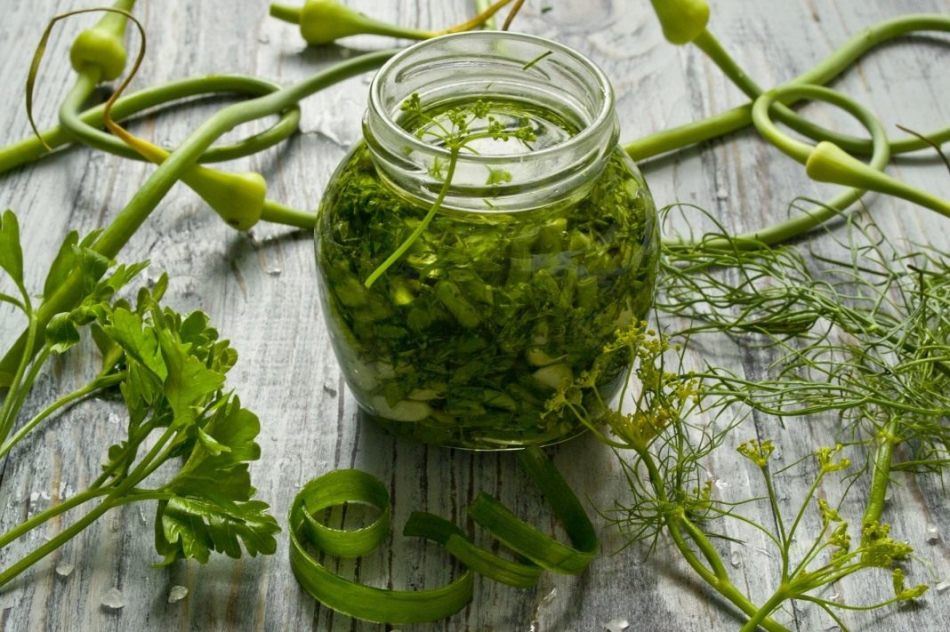
This is an excellent herb seasoning for soups and salads.
Ingredients:
- bunch of dill
- bunch of parsley
- 150 g green onions
- 150 g garlic cloves
- 1 head of garlic
- 25 g salt
- 100 ml sunflower oil
Recipe:
- Chop the dried herbs with a knife. Cut the garlic cloves into strips.
- Wash the onion and cut it into strips. Stir the greens in a saucepan and season with salt. Bring grated garlic.
- Remember everything with your hands so that the mixture starts up the juice. Divide the green paste halfway between sterilized jars. Pour in the oil.
- Fill the jar up to the shoulders and pour in some oil again. Screw on the lids and store in the refrigerator.

Seasoning from basil: harvesting for the winter
Unusual seasoning for spaghetti. When mixed with cheese, pesto is obtained.
Ingredients:
- bunch of basil
- 6 walnuts
- 50 ml olive oil
- 4 cloves of garlic
Recipe:
- Wash the basil greens and dry them. Pass through a meat grinder or finely chop.
- Clear walnuts and turn them into crumbs, mix with green mass.
- Enter the grated garlic and olive oil. Pour into jars and sterilize for 15 minutes.

An unusual addition to meat dishes and barbecue.
Ingredients:
- 2 bunches of parsley
- 2 bunches of basil
- 1 bunch celery
- Ground black pepper
- 4 heads of garlic
Recipe:
- Wash and dry the greens using a towel. Mince the basil, parsley and celery
- Peel and mince the garlic. Enter salt and spices. Squeeze the mixture to release the juice.
- Pour the mixture into sterilized jars and roll up.
This spicy mixture goes well with sour cream and mayonnaise. It can be added to salads, sauces and main dishes.
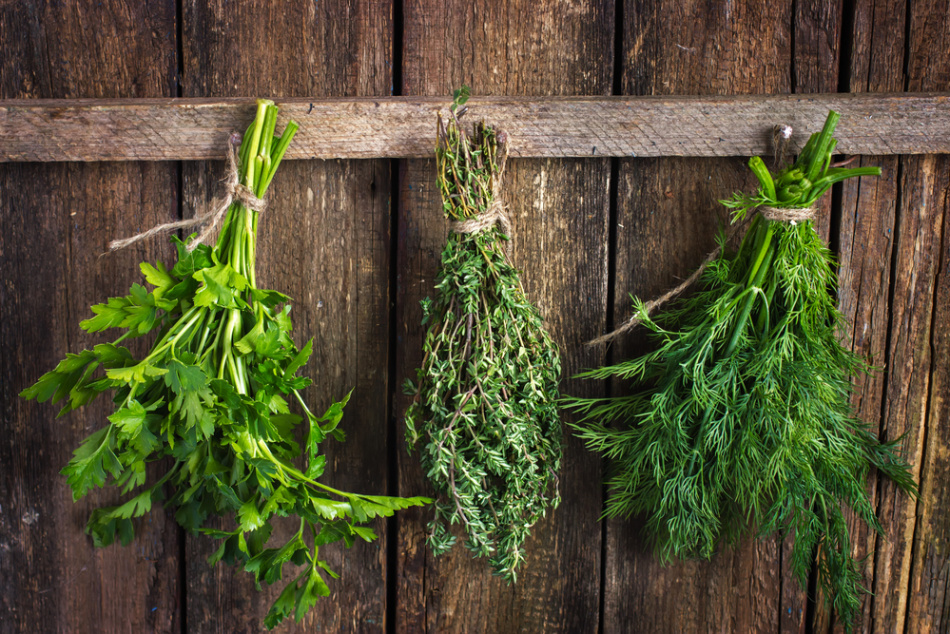
In winter, it is quite easy to find green onions in supermarkets. But unfortunately it is not so fragrant and tasty. Therefore, we suggest cooking onion pasta on your own in the summer. In winter, you can use this pasta to complement the first and second courses.
Ingredients:
- 1 kg green onion
- 100 ml sunflower oil
- 40 ml vinegar
Recipe:
- Peel the onion from the husk and wash the greens. Pass the onion through a meat grinder and add salt, vinegar and oil.
- Pour into jars and sterilize for 10 minutes. Close with plastic lids and store in the cellar.
- In winter, this paste can be smeared on bread or supplemented with first courses.
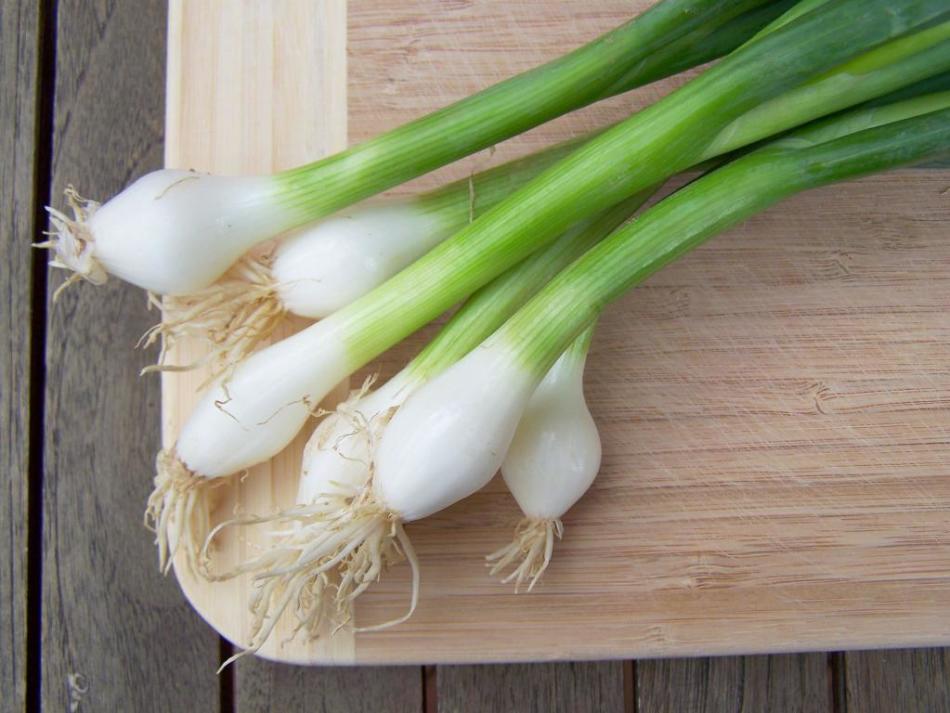
Seasonings from greens - a source of vitamins and useful substances. With their help, you can improve immunity and diversify the menu.
Cooking secret:
- Prepare seasonings from greens in season. So, greens will retain a maximum of juice and aromatic substances. The sauce will be spicy and flavorful.
- Before cooking, be sure to wash and dry the herbs on towels. Never crush fresh leaves. So, they will retain a maximum of juice.
- Don't be afraid to experiment and mix different greens. Parsley goes well with cilantro, basil and dill.
- If you cook seasoning without sterilization and vinegar, then you need to store it in the cold.
- To prevent the formation of mold, pour a layer of vegetable oil on top of the seasoning.
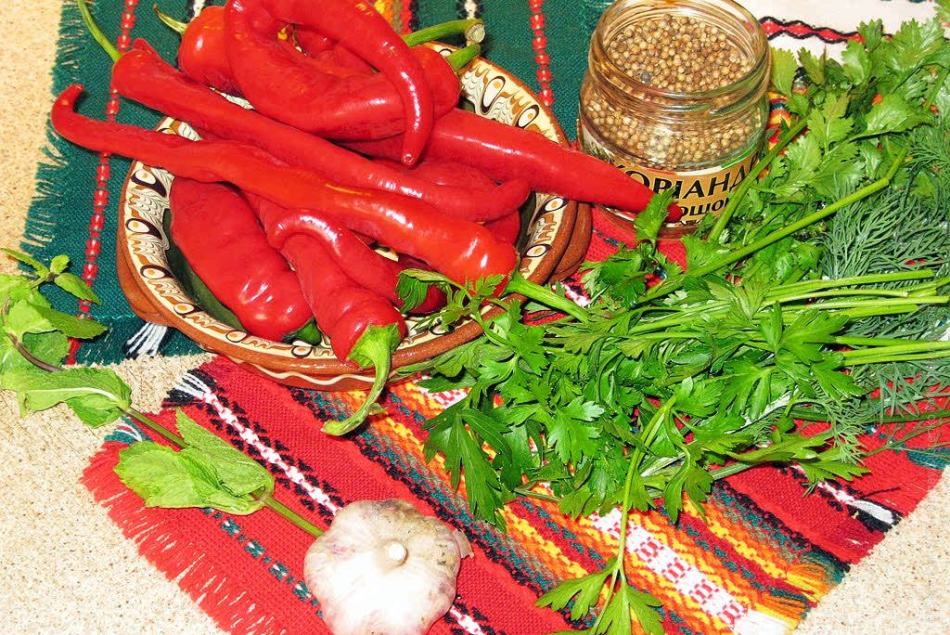
Preparing herb seasoning is quite simple. Be sure to treat yourself and your loved ones delicious preparations for the winter.
You ask, how to prepare fresh herbs for the winter. Yes, it's actually very easy to do. There are many different recipes for harvesting various herbs for the winter. It can be drying, pickling, freezing. One of the ways to harvest for the winter is salting.
- Basil 2 bunches.
- Celery 1 bunch.
- Parsley 2 bunches.
- Seasoning hops-suneli 1 pack.
- Garlic 4 small heads.
- Salt half a glass.
- Ground hot pepper 2 tablespoons.
- Sterile jars and lids.
Spicy pasta from fresh herbs for the winter - recipe
You can take absolutely any greens for such a paste. What kind of greens do you like, what kind do you like and prefer, and take that one to prepare this pasta. All necessary greens must be thoroughly washed before cooking. First, soak all bunches of greens in a large container.
Then rinse it one by one under running water. This is especially true of celery and basil. As basil and celery big leaves then try to wash each leaf individually. When you rinse your greens, place them on a clean towel. Or rather, even spread the greens on a towel to dry. If you have a special gadget for drying greens, then, of course, use it.
You need to wash the jars and lids. And then they need to be sterilized. I usually sterilize like this. Once I bought a special circle in the hardware store for sterilizing jars. I put the circle on the pan, into which I pour half the water. Then, on this circle, I put a jar.
And thus, the jars are sterilized. It happens that you need to sterilize very small jars. Then I proceed as follows. I put the jar upside down on the circle. And the bank is sterilized.

I grind all the washed greens in a meat grinder. First I chopped the basil. Here he is black and ugly. But it is he who gives the paste that piquant note, for which I love it. Sauces prepared with this pasta are always very popular with everyone.

Next in the meat grinder, I chopped the celery.

Lastly, I chopped the parsley along with the peeled and washed garlic.
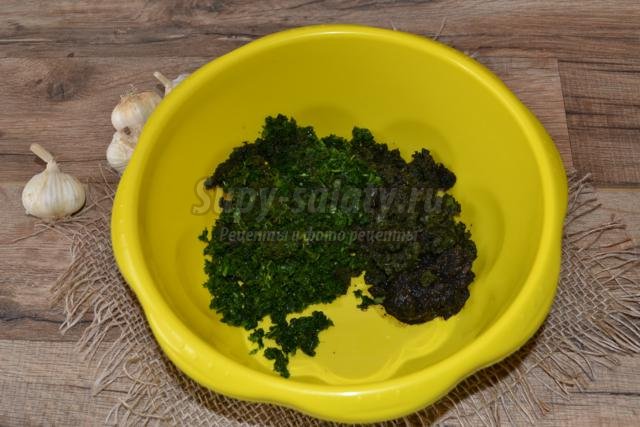

Having printed out a bag of hop-suneli seasoning, she added it to the greens twisted in a meat grinder.


After that, I mixed everything with a spoon. When I mix the pasta, I press it a little with a spoon. This must be done in order for the juice to come out of the greens.

When all the greens are mixed, I transfer them to clean sterile jars. Jars should be sealed with sterile lids. After that, the jars should be put in the refrigerator or cellar. Of course, you can store spicy herbs at room temperature. But for greater reliability, it must still be stored in the refrigerator.
That's exactly what I do. Spicy pasta from fresh herbs for the winter literally worth it whole year and nothing happens to her. The only thing is that it may lose color a little. But it doesn't affect the taste. As promised, here are some recipes for making sauces with spicy herbs.
Adjika recipe for the winter without cooking
3 (60%) 2 votesAdjika without cooking is a hot, red-orange seasoning similar to paste with salt, various herbs, and garlic. This seasoning is not difficult to prepare, however, despite this, it can be a great addition to many dishes.
There are a myriad of recipes for cooking adjika without cooking (many people really like it with garlic and tomatoes). For long-term storage, it can be boiled and preserved, or it can be stored raw in the refrigerator. The second method is much simpler than the first, not to mention the fact that in this case more vitamins will remain in the workpiece when compared with canned.
Adjika for the winter without cooking with bell pepper
Ingredients needed for cooking:
- sweet bell pepper- 3 kg;
- cilantro - 2 bunches;
- basil - 2 bunches;
- parsley - 2 bunches;
- garlic - 2 heads;
- chili (pods) - 200 gr;
- grape vinegar - 1 bottle;
- coarse salt.
Rinse each component thoroughly, peel the pepper, discard the seeds. Twist the ingredients in a meat grinder, add 2-3 tbsp. l. salt. Stir gently, season with vinegar (not the whole bottle), mix the resulting product again. The salt will not melt immediately, so it is worth stirring until it is completely dissolved.
Arrange in washed containers and send adjika for storage (balcony, refrigerator, basement).
Tomato and garlic adjika recipe without cooking (everything is fresh)
You will need:
- tomatoes - 3 kg;
- pepper (sweet) - 1 kg;
- garlic - 0.5 kg;
- pepper (hot) - 150 g;
- salt - 0.5 tbsp.;
- sugar - 3 tbsp. l.
Grind the ingredients in a blender (twist in a meat grinder, food processor etc.), mix, add salt. At night, the container with adjika should be on the balcony (basement, in another place with low air temperature). Pour out excess water in the morning. Distribute the rest among banks. Keep in a cold place. 
How to prepare pumpkin juice for the winter: recipe link
Mild adjika with plums

Ingredients:
- 3.5 kg of tomatoes;
- 1 kg of sweet peppers;
- about 1 kg of carrots;
- 1 kg plums;
- 100 g of garlic;
- 0.5 tbsp vegetable oil;
- ten aspirin tablets.
Washed tomatoes, onions and plums and other vegetables - scroll in a meat grinder. Add garlic cloves, salt, seasonings (depending on preferences), aspirin, crushed with the help of a spadefoot to the paste and stir thoroughly.
Recipe without cooking with horseradish and garlic
Have with you:
- 2 kg of tomatoes;
- 1 kg of sweet pepper;
- about 300 g of garlic;
- 0.3 kg of chili;
- 300 g of fresh horseradish rhizomes;
- 1 st. salt;
- 1 st. 9% vinegar.
Beat in a blender (hold) tomatoes and both types of pepper, garlic and horseradish roots, also twist. Sprinkle with salt and vinegar according to taste, mix everything. Place the resulting mass in washed and dried jars, close. Adjika should be stored in a cold place. The result is approximately 3 liters of excellent workpiece for the winter.
Recipe for adjika with eggplant
Components:
- 3 kg of fried eggplant;
- 1 kg of sweet red pepper;
- about 0.5 kg of onion;
- 500 g tomato;
- 100 g of garlic;
- 100 g of peeled hot pepper;
- 200 ml of vinegar;
- 250 g parsley (greens and root).
Cut the components for adjika without cooking into small pieces, add salt according to preferences, overcook for 2 days, send for storage in a cold place.
- An important point when preparing the workpiece is not to reduce the amount of salt. Put exactly as much as indicated in the recipe, otherwise the seasoning will become moldy or ferment.
- It is recommended to use only red products (tomatoes, bell peppers (it always turns red closer to autumn), chili), as adjika looks more appetizing with them.
- To make grilled meat with a bright, fried crust, pre-roll it in a spicy seasoning.
- To get a “Caucasian” flavor, be sure to add ground coriander to the preparation (1-2 tablespoons per 2-3 kg of tomato will be enough) or a bunch of cilantro. You can also add walnuts.
Fragrant adjika is ideal in combination with meat, fish, cereals, potatoes, baked vegetables. The main components of hot sauce are pepper and garlic, beneficial features which allows you to save adjika, cooked without cooking.
The benefits of this sauce are obvious, and the recipes are very easy to follow. This is not surprising, because to prepare a fragrant spicy seasoning, you just need to chop the vegetables, combine them with spices, salt, oil or vinegar and arrange them in jars. Fresh garlic will help you survive the winter cold without a cold, and tomatoes, peppers and herbs will provide the body with essential minerals and vitamins.
Adjika for the winter without cooking - general principles of cooking
To prepare adjika from tomatoes for the winter without cooking, it is better to choose coarse salt and purple garlic. Salt should not contain any additives - additional flavors should give the sauce spices and herbs. You can take any pepper: green, red, yellow, hot chili and sweet paprika. Combinations of various herbs with a tomato-garlic base can be varied as you like, focusing only on your own taste and creating original recipes.
Georgian cuisine is characterized by a combination of hot pepper, garlic, herbs, spices and salt. Russian cuisine allows the introduction of flavor softening components - tomatoes, apples, carrots - into this base.
Adjika for the winter without cooking - recipe 1
The basis of adjika from tomatoes for the winter without cooking is pepper and garlic. This is the main spicy sauce Slavic cuisine. For cooking, you will need fleshy ripe tomatoes, sugar and vinegar. The recipe is designed for a large amount of the finished product - the output will be about six liters. If you need a little adjika, then you should proportionally reduce the weight and volume of these ingredients.
Ingredients:
Six kilograms of tomatoes;
Six hundred grams of garlic;
Two kilograms of sweet pepper (it is better to take red);
Eight pieces of chili peppers;
Two tablespoons of sugar;
Six tablespoons of salt;
Ten tablespoons of vinegar 9%.
Cooking method:
Wash and sterilize jars with lids.
Rinse vegetables, dry, cut the stalks and spoiled places, clean from seeds and husks.
Cut the tomatoes, let the excess liquid drain (put in a colander or deep bowl). One and a half hours will be enough.
Twist the tomatoes through a meat grinder.
Pass pepper and garlic twice through the fine grate of the meat grinder.
Mix vegetables, sugar, salt, vinegar, arrange in jars. If long-term storage is not necessary, then it is not necessary to roll up metal lids, plastic lids are well washed and scalded with boiling water (too hot boiling water can ruin the lids). The sauce can be consumed immediately.
Adjika for the winter without cooking - recipe 2
Adjika from apples for the winter without cooking "Apple-carrot" is a soft, fragrant, spicy sauce, for the preparation of which apples, tomatoes, peppers, garlic and carrots are used. The beauty of this adjika is that the proportions can be changed, taking into account your own taste. However, apples for this recipe need quite dense and sour. Sweet fruit will make the sauce cloying.
Ingredients:
Half a kilo of ripe tomatoes;
Three hundred grams of apples;
Half a kilo of bell pepper;
Four or five pods of hot pepper;
300 grams of carrots;
The same amount of peeled garlic and parsley root;
One hundred grams of mustard;
Two tablespoons of tomato paste; a glass of 9% vinegar;
Salt to taste.
Cooking method
Prepare vegetables. Rinse, peel, seeds, tails, cut into pieces.
Peel the apples from the skin and core, cut into slices.
Using a meat grinder with a fine grate, separately chop the vegetables and apples to a liquid sauce.
Add to mass tomato paste, salt, mustard, vinegar, mix everything thoroughly with a wooden spatula.
When the ingredients are finally combined, pour the sauce into jars. You can eat right away, but it is better to give adjika one or two days to brew.
Banks should be closed plastic lids, since it will still have to be stored in the refrigerator or cellar.
Especially rich taste sauce will be available in a week. Apple juice will give it astringency and sourness, and fruit pulp will give tenderness and soft texture.
Adjika for the winter without cooking - recipe 3
The original taste of freshness has adjika from celery for the winter without cooking "Fresh Look". Tomatoes are replaced with tomato paste in this recipe. Celery is useful in diseases of the kidneys, stomach, liver, intestines. Cooking raw, uncooked adjika with this vegetable allows you to get extremely healthy and very delicious sauce with a special tart, spicy note. From the specified amount of ingredients, up to five liters of finished adjika are obtained.
Ingredients:
Three liters of tomato paste;
25 pieces of medium bell pepper;
Twelve pieces of hot chili pepper;
18 heads of garlic (you can take a kilogram);
Two hundred grams of celery;
The same amount of dill and parsley;
Two tablespoons (with a slide) of salt;
12 tablespoons of sugar;
18 teaspoons of vinegar essence (70%).
Cooking method:
Peel the garlic, bell and hot pepper. Together with the stalks, you need to remove the seeds, films.
Pass pepper, garlic, celery, parsley and dill twice through a fine meat grinder. If desired, the greens can be simply chopped.
Add in the tomato paste, stir.
Add sugar, salt, acetic acid and mix adjika again.
Arrange the sauce in jars, having previously thoroughly sterilized them along with the lids.
Roll up the banks. Adjika with celery for the winter without cooking is stored only in a dark, cool place.
Adjika for the winter without cooking - recipe 4
It is quite simple to prepare the Piquant sauce - the original onion adjika for the winter without cooking. Usually, onions are not used for cooking adjika, especially in original Caucasian sauces. The peculiarity of the recipe below is the simultaneous use of garlic and onions for a particularly strong taste. The addition of oil allows the sauce to store better. The use of overripe tomatoes is allowed and even encouraged.
Ingredients:
Three kilograms of tomatoes;
Five pieces of large bell pepper;
Four pieces of hot pepper;
Five large bulbs;
head of garlic;
Five tablespoons of 9% vinegar;
Seven tablespoons of vegetable oil;
Salt to taste.
Cooking method:
Prepare vegetables by washing them, peeling them from films, seeds, husks, stalks.
Cut vegetables into pieces and turn through a meat grinder. You can give the sauce the desired consistency by chopping vegetables in a food processor or blender.
Transfer the mass to a large container, add oil, vinegar, spices to taste, mix. Leave the prepared sauce for an hour to infuse.
While onion adjika is infused for the winter without cooking, you need to prepare half-liter jars: wash, sterilize for 10 minutes, not forgetting the lids.
Remove hot jars from the sterilizer, fill with adjika and immediately roll up.
Cool the jars upside down, wrapping them tightly with a blanket. After cooling, send to a cool place for storage.
Adjika for the winter without cooking - recipe 5
The adaptation of the Caucasian recipe to the traditions of the Russian culinary school led to the creation of a sauce with the addition of horseradish. Adjika from horseradish for the winter without cooking has many names in Russian cuisine(“Spark”, “Hrenovina”, “Appetizing”) and it turns out very spicy, spicy, rather tart.
Ingredients:
Two kilograms of tomatoes;
Three chili peppers;
Three heads of garlic;
150 grams of horseradish (dense white root);
Three tablespoons of salt and black pepper.
Cooking method:
The technology for preparing adjika is similar to the above. Wash vegetables, chop, season with salt and pepper, roll up in sterilized jars, put in the cold. Adjika with horseradish is stored for quite a long time - up to three years.
Adjika for the winter without cooking - recipe 6
Adjika with herbs for the winter without cooking is very good for meat. Preparing the traditional sauce is very simple. In addition to cilantro, dill, parsley and suneli hops, you can safely use traditional Russian herbs that are typical for a particular area: thyme, mint, basil.
Ingredients:
Two kilograms of bell pepper;
Three heads of garlic with large cloves;
400 grams of hot pepper;
One large bunch of dill, parsley, cilantro;
Five tablespoons of suneli hops;
Three teaspoons of ground black pepper;
Two tablespoons of peppercorns;
Half a glass of salt.
Cooking method:
Clean and cut vegetables.
Greens carefully cut with a knife.
Grind vegetables and herbs in a food processor or meat grinder until smooth.
Add salt, seasonings, pepper to the mass and mix.
While the sauce is settling, sterilize the jars. Pour adjika into jars, immediately roll up, cool upside down on the lids.
Raw adjika should be stored in the cold. The sauce with tomatoes and herbs goes especially well with meat.
Adjika for the winter without cooking - recipe 7
Traditional Georgian cuisine is unthinkable without walnuts. Adjika from walnuts for the winter without cooking is the original Georgian hot sauce. It goes well with meat dishes. It turns out quite thick, the nut mass gives this sauce some oiliness and makes it quite satisfying.
Ingredients:
Half a kilo of red hot pepper;
Three kilograms of bell pepper;
Half a kilo of garlic;
Two glasses of shelled walnuts;
Three bunches of cilantro;
Half a glass of salt.
Cooking method:
Wash and dry vegetables.
Remove shells and membranes from walnuts.
Cut the stem off the peppers, remove the seeds and rinse again.
Crush the peeled walnuts in a mortar. If not, you can get by with a regular rolling pin. Place the nuts in a bag or wrap in a paper towel, put on a wooden board and roll vigorously with a rolling pin to grind.
Bring vegetables and herbs to a paste-like state in a food processor or pass them twice through a meat grinder with a fine grate.
Combine vegetable sauce and walnut paste, salt and mix well.
Leave adjika for an hour: the sauce should brew.
While adjika is infused, you can start sterilizing jars and lids. If there is no sterilizer, an ordinary pan with a special metal circle installed on it for sterilizing cans will do.
Arrange the finished adjika in jars, roll up and put away for storage in a cold dark place. Part of the sauce can be poured into a plastic container for immediate use and stored in the refrigerator.
- No adjika is complete without a large number garlic. It takes quite a while to clean up. To make your work easier, you can put the right amount of garlic heads in the refrigerator. After half an hour, put them in a bag or towel and vigorously hit the table. You will have to tap the garlic for two to three minutes, but the result will please you: garlic cloves will be very easy to separate from the husk.
- You need to clean hot peppers in thin rubber or plastic gloves. Pepper will simply burn the bare skin of the hands. For the same reason, you can work only in a well-ventilated area, and preferably with an open window.
- Adjika without cooking is good not only for meat. The sauce is perfect in combination with fish or vegetables, rice and buckwheat are good.
- If you want to achieve a more refined taste, you can grind the ingredients not in a blender or meat grinder, but separately: chop the garlic into small pieces or grate, chop the nuts with a rolling pin or grind in a mortar, and chop the greens with a knife. From exactly how certain products were crushed, the taste of the final dish will be flooded.
- It is good to add coriander, zira, Imeretian saffron to spicy adjika from tomatoes for the winter without cooking. Lighter versions of the sauce allow the use of other spices - bay leaf and marjoram.
- No need to be afraid of culinary experiments: adjika loves them. Basil, thyme, mint, Imeretian saffron, ucho-suneli (blue fenugreek), dill seed, zira, coriander and even cinnamon can be an excellent material for culinary creativity.
- Not all recipes allow the use of overripe tomatoes. These vegetables contain a lot of liquid. Cooking raw will prevent excess moisture from evaporating, so the sauce may be too thin.
- Uncooked adjika can easily deteriorate if stored at normal room temperature. The best place For raw sauce- refrigerator and cellar. Preservatives increase the chances of survival: salt, vinegar, vegetable oil.
- An unusual method of making adjika from tomatoes for the winter without cooking is the use of natural fermentation. You need to leave the sauce to ferment at room temperature - usually the process takes three to four days. As soon as the mass ferments, it must be poured into plastic bottles, thoroughly without topping up to the neck, and put in the refrigerator (you can try putting one container on the balcony). Such a sauce can be stored for up to three years, while maintaining the freshness of the main components. Pickled vegetables are very beneficial for health.





